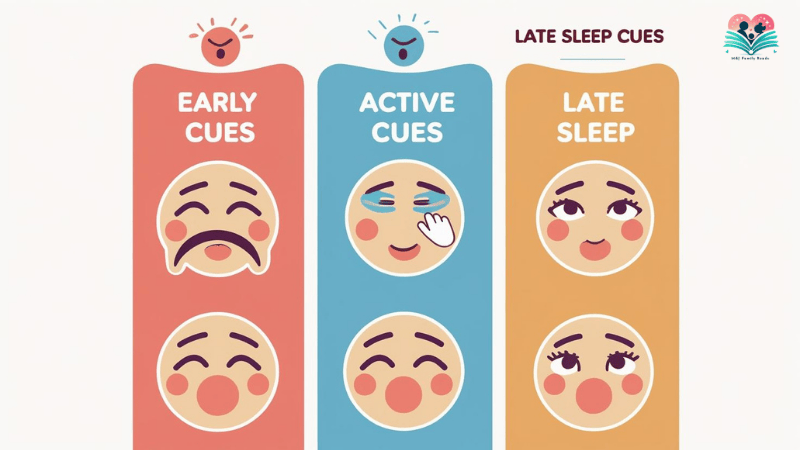Spoiler alert: How to Spot Your Baby Sleep Cues – they’re just whispering in Baby Code, not shouting in neon signs. And if you’ve ever felt like you missed the memo (or the manual), you’re definitely not alone.

Picture this: It’s 2:47 AM. You’re pacing the hallway, bouncing your baby like a yoga ball with your feet. They’re overtired, overstimulated, and somehow… still wide awake. You’re googling “Is it normal for babies to NEVER sleep?” Watching with one eye, rocking with the other – parenting in motion.
Mama, breathe. You’re not broken. And neither is your baby.
What’s actually happening? Chances are, you’ve missed their early sleep cues – not your fault! Nobody hands out a “How to Read Baby Body Language” diploma at birth. But today? We’re decoding the mystery together.
In this guide, How to Spot Your Baby Sleep Cues isn’t just a skill – it’s your secret weapon for calmer nights and confident mama moments.
Sleep cues are your baby’s way of waving a little sleepy flag that says, “I’m ready for a nap now, please and thank you.” And like any flag, the earlier you see it, the smoother things go. Miss the flag? Suddenly, you’ve got a tiny angry owl at midnight, refusing to blink.
When we catch those early signals, bedtime becomes less of a battle and more of a peaceful drift. But first, we’ve got to know what to look for.
These are the goldmine! Catch these, and you might just win bedtime:
🧠 Pro Tip: Babies won’t yawn dramatically here. You’ve got to watch the subtle stuff.
If you missed the early ones, here comes round two:
This is your cue to start winding things down – dim the lights, lower the voice, and cue your calming bedtime ninja routine.
By now, your baby has flipped into “wired” mode:
If your baby’s losing their tiny mind every evening around the same time, there’s a good chance they needed sleep 30 minutes ago.
Here’s the game plan, mama:
🎯 Case in Point: Emma, a first-time mum, tried sticking to a strict 7:00 PM bedtime. Her baby? Wanted to sleep at 6:30 PM. Once she started watching her daughter’s eye-rubbing and slow-motion blinking, bedtime battles turned into sleepy snuggles. Victory.
You’re not doing it wrong – you’re learning. And guess what? That’s exactly what good mums do.
One key takeaway from learning how to spot your baby sleep cues is recognizing that yawning or even a baby’s glazed look can be the perfect signal to start winding things down.
✔ Zoning out
✔ Eye rubbing
✔ Red eyebrows
✔ Sudden fussiness
✔ Turning head away
✔ Jerky movements (late cue!)
✔ Yawning (don’t wait for this one!)
Pop this list on your fridge. Seriously. Middle-of-the-night, you will thank you.
Following the AAP’s safe sleep recommendations, like using a firm surface and supervising tummy time, helps reduce SIDS risk and supports healthy sleep habits.
“What if I miss it every time?”
→ Then you get another chance tomorrow. Parenting is a million tiny do-overs.
“My baby never shows cues!”
→ Some cues are quieter than others. Use age-appropriate wake windows + gut feeling.
“Does rocking them to sleep mean spoiling them? Let’s rethink that.”
→ Nope. You’re comforting a human. There’s no expiration date on love.
Reading your baby’s sleepy signals isn’t about being perfect – it’s about tuning into them. The more you observe, the more confident you’ll become. It’s not a test. It’s a bond.
And if you’re looking for a gentle, no-cry system that actually works (without making you feel like a sleep-deprived zombie-slash-failure), the “Rest Together, Thrive Together” guide was made for mums like you.
You’ve got this. Nap when you can. Cry when you need to. And know that your baby already thinks you’re doing an amazing job.

Gentle Parenting Toddler Tantrums | Best No.1 Calm Technique says:
[…] Fatigue – When toddlers miss sleep, even the tiniest hiccup can spark a storm.Want to prevent fatigue meltdowns before they start? Read our guide on how to spot your baby sleep cues before it’s too late and they’re overtired […]